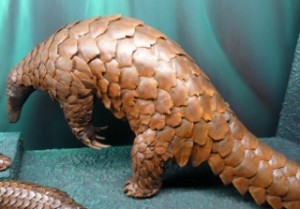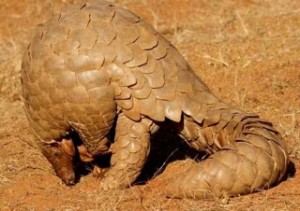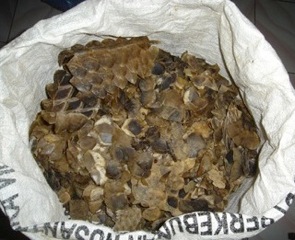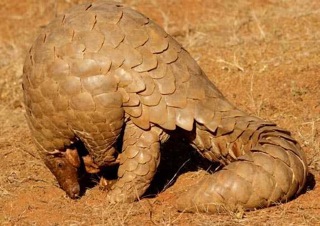The pangolin is one of those lesser-known animals, at least in the West, most commonly seen as slightly dusty museum specimens (there’s one in our own zoology museum). Yet across their native lands they’re well known and very popular. Unfortunately this popularity is as food and traditional medicine. Indeed, recently the IUCN released a report saying, of the Chinese pangolin, “they are more than likely the most traded wild mammals globally”. This statement came following the first international conference on the conservation of pangolins, held by the IUCN. There is a very real fear that the Chinese pangolin and its relatives will be eaten to extinction.
 I first became aware of the plight of the pangolin when I saw an article last year. A ship had run aground in a UNESCO World Heritage site in the Philippines (violating several laws in the process). When the ship was rescued it was found to contain 400 boxes of frozen pangolins, totalling 2,000 animals. All illegally caught, shipped and intended for trade on the black market. In searching for the news report I saw all that time ago I discovered that this was a remarkably common occurrence with illegal shipments being so widespread as to be almost mundane.
I first became aware of the plight of the pangolin when I saw an article last year. A ship had run aground in a UNESCO World Heritage site in the Philippines (violating several laws in the process). When the ship was rescued it was found to contain 400 boxes of frozen pangolins, totalling 2,000 animals. All illegally caught, shipped and intended for trade on the black market. In searching for the news report I saw all that time ago I discovered that this was a remarkably common occurrence with illegal shipments being so widespread as to be almost mundane.
So what is a pangolin and why are they in such high demand? The pangolin is a generic name for eight species of the genus Manis. The name comes from the Malay word pengguling which means “roller”, a nod to one of its key features: that of its ability to roll into a ball when threatened. Its alternative name, scaly anteater, acknowledges its other major features: the large scales that cover its body and its similarity in appearance and diet to the anteater. They are solitary, nocturnal and secretive creatures, found across Asia and Africa. Four species are found in Asia: the Indian pangolin (M. crassicaudata), the Chinese pangolin (M. pentadactyla), the Malayan pangolin (M. javanica) and the Philippine pangolin (M. culionensis) and four species are found in Africa: the cape pangolin (M. temmincki), the tree pangolin (M. tricuspis), the giant ground pangolin (M. gigantea) and the long-tailed pangolin (M. tetradactyla).
 They are insectivorous, preferring ants and termites but branching out to other invertebrates, such as worms and crickets, when the mood or circumstances take them. Some are arboreal while others live mostly on the ground. They are sexually dimorphic with males being larger than females. Males have larger territories than females and their territories often cross, resulting in meetings that may lead to matings when the female is in oestrus. A single offspring is usually born and is carried by the mother on her tail for about 3 months until it is weaned. It stays with her for a further two months before leaving to find its own territory. It is not known how long pangolins live in the wild, though they have survived for 20 years in captivity.
They are insectivorous, preferring ants and termites but branching out to other invertebrates, such as worms and crickets, when the mood or circumstances take them. Some are arboreal while others live mostly on the ground. They are sexually dimorphic with males being larger than females. Males have larger territories than females and their territories often cross, resulting in meetings that may lead to matings when the female is in oestrus. A single offspring is usually born and is carried by the mother on her tail for about 3 months until it is weaned. It stays with her for a further two months before leaving to find its own territory. It is not known how long pangolins live in the wild, though they have survived for 20 years in captivity.
Pangolins do not, to my eyes at least, look particularly appetising, but there is clearly a demand for them. The best estimates are that between 91,000 and 183,000 were traded in the years 2011 to 2013. For an animal with a low reproductive rate this level of hunting is clearly unsustainable. And all this trade is illegal under CITES (Convention on International Trade in Endangered Species). The demand is such that people are willing to risk prosecution and imprisonment. But what is driving this demand?
Unfortunately, it seems to be that much of the trade in pangolins is driven by the fact that eating them is seen as something of a status symbol. As they become rarer the prices go up, and this only adds to the appeal. An article from last year said that a restaurant in Ho Chi Minh City sold pangolins for between $600 and $700! Doing some ‘back of a napkin’ sums, this is about 3 months average wage in Vietnam, or the equivalent of spending about €10,000 on a main course in Ireland. There is no food that could be so tasty as to be worth that much. This is not about the quality of the food but the experience of being able to say to your friends “I have so much money I was able to eat pangolin last night”. I wouldn’t be surprised if it turned out that pangolin actually tasted pretty disgusting (I almost hope it does!).
The other use for pangolins is in Traditional Chinese Medicine. Ignoring the fact that “traditional” Chinese medicine was invented by Mao in the 1950s, pangolin scales are keratin, the same stuff that makes up your hair and nails. Yet still hundreds of kilos of scales enter the black market as they are said to be associated with the “liver and stomach channels” and treat a range of conditions mostly involving blood and pus.
 The solution to the black market trade in pangolins is not easy. The rarer it gets the more valuable it becomes, both in itself and as a status symbol. I don’t know how you go about changing that attitude. Given that it seems to be considered an aphrodisiac in some regions, there is a lot of cultural baggage surrounding this poor creature. How do you try and convince people that eating pangolins will not increase your virility or that eating their scales will not improve your blood circulation? The easy answer is ‘education’ but this is only part of the solution because I doubt that many of the people eating pangolin really do so as an expensive form of Viagra, they do it because it’s an easy way to show they have money and that is a much harder cultural attitude to change.
The solution to the black market trade in pangolins is not easy. The rarer it gets the more valuable it becomes, both in itself and as a status symbol. I don’t know how you go about changing that attitude. Given that it seems to be considered an aphrodisiac in some regions, there is a lot of cultural baggage surrounding this poor creature. How do you try and convince people that eating pangolins will not increase your virility or that eating their scales will not improve your blood circulation? The easy answer is ‘education’ but this is only part of the solution because I doubt that many of the people eating pangolin really do so as an expensive form of Viagra, they do it because it’s an easy way to show they have money and that is a much harder cultural attitude to change.
So, pity the poor pangolin. Ignored in the West, revered in the East: as food, aphrodisiac, and alternative to chewing your nails.
Author: Sarah Hearne, hearnes[at]tcd.ie, @SarahVHearne
Image Sources:
Wikicommons
Scale image from http://bit.ly/1m7QGGW courtesy of TRAFFIC.


I have seen a news about 21 frozen pangolins and 16 sea turtles, all dead found inside a truck. The truck driver was detained while charges for illegal trafficking of wildlife were being prepared by authorities.